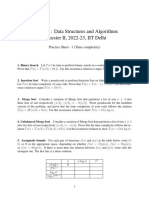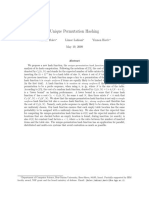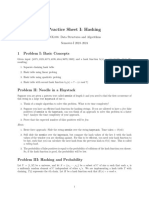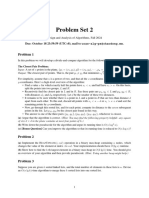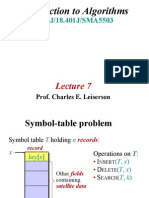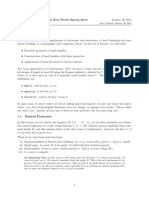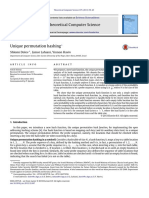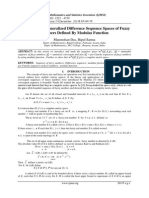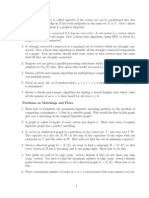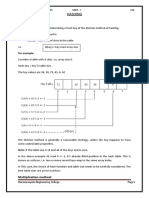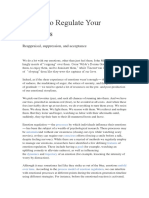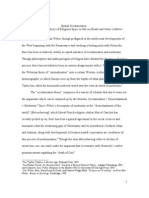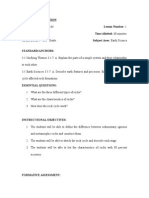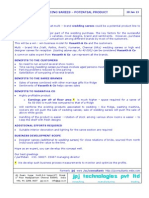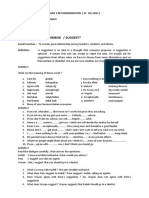Questions 11
Questions 11
Uploaded by
test789000Copyright:
Available Formats
Questions 11
Questions 11
Uploaded by
test789000Copyright
Available Formats
Share this document
Did you find this document useful?
Is this content inappropriate?
Copyright:
Available Formats
Questions 11
Questions 11
Uploaded by
test789000Copyright:
Available Formats
11.1-4 _ We wish to implement a dictionary by using direct addressing on a huge array.
At the start, the array entries may contain garbage, and initializing the entire array is impractical because of its size. Describe a scheme for implementing a directaddress dictionary on a huge array. Each stored object should use O(1) space; the operations SEARCH, INSERT, and DELETE should take O(1) time each; and the initialization of the data structure should take O(1) time. (Hint: Use an additional stack, whose size is the number of keys actually stored in the dictionary, to help determine whether a given entry in the huge array is valid or not.) 11.2-1 Suppose we use a hash function h to hash n distinct keys into an array T of length m. Assuming simple uniform hashing, what is the expected number of collisions? More precisely, what is the expected cardinality of {{k, l} : k _= l and h(k) = h(l)}? 11.2-4 Suggest how storage for elements can be allocated and deallocated within the hash table itself by linking all unused slots into a free list. Assume that one slot can store a flag and either one element plus a pointer or two pointers. All dictionary and free-list operations should run in O(1) expected time. Does the free list need to be doubly linked, or does a singly linked free list suffice? 11.3-3 Consider a version of the division method in which h(k) = k mod m, where m = 2 1 and k is a character string interpreted in radix 2 . Show that if string x can be derived from string y by permuting its characters, then x and y hash to the same value. Give an example of an application in which this property would be undesirable in a hash function. 11.3-5 _ Define a family H of hash functions from a finite set U to a finite set B to be universal if for all pairs of distinct elements k and l in U, Pr {h(k) = h(l)} where the probability is taken over the drawing of hash function h at random from the family H. Show that an _-universal family of hash functions must have
11-1 Longest-probe bound for hashing A hash table of size m is used to store n items, with n m/2. Open addressing is used for collision resolution.
a. Assuming uniform hashing, show that for i = 1, 2, . . . , n, the probability that the ith insertion requires strictly more than k probes is at most 2 . b. Show that for i = 1, 2, . . . , n, the probability that the ith insertion requires more than 2 lg n probes is at most . Let the random variable Xi denote the number of probes required by the ith insertion. You have shown in part (b) that Pr {Xi > 2 lg n} variable X = max of the n insertions. . Let the random Xi denote the maximum number of probes required by any
c. Show that Pr {X > 2 lg n} 1/n.
d. Show that the expected length E [X] of the longest probe sequence is O(lg n). 11-2 Slot-size bound for chaining Suppose that we have a hash table with n slots, with collisions resolved by chaining, and suppose that n keys are inserted into the table. Each key is equally likely to be hashed to each slot. Let M be the maximum number of keys in any slot after all the keys have been inserted. Your mission is to prove an O(lg n/ lg lg n) upper bound on E [M], the expected value of M. a. Argue that the probability Qk that exactly k keys hash to a particular slot is given by
b. Let Pk be the probability that M = k, that is, the probability that the slot containing the most keys contains k keys. Show that
c. Use Stirlings approximation, equation (3.17), to show that
11-3 Quadratic probing Suppose that we are given a key k to search for in a hash table with positions 0, 1, . . . ,m 1, and suppose that we have a hash function h mapping the key space into the set {0, 1, . . . ,m 1}. The search scheme is as follows. 1. Compute the value i h(k), and set j 0. 2. Probe in position i for the desired key k. If you find it, or if this position is empty, terminate the search. 3. Set j ( j + 1) mod m and i (i + j ) mod m, and return to step 2. Assume that m is a power of 2. a. Show that this scheme is an instance of the general quadratic probing scheme by exhibiting the appropriate constants c1 and c2 for equation (11.5). b. Prove that this algorithm examines every table position in the worst case.
You might also like
- Daa Unit 3Document91 pagesDaa Unit 3Abhishek FfNo ratings yet
- Planet Hoppers 13Document7 pagesPlanet Hoppers 13SW-FanNo ratings yet
- CH 11Document42 pagesCH 11LeonardoMadeira11No ratings yet
- Dfs 18 MidtermDocument2 pagesDfs 18 Midtermyuzurihainori10121996No ratings yet
- Hash TableDocument4 pagesHash Tablesara.lu.9210No ratings yet
- 14 HashingDocument23 pages14 Hashingmu511ckNo ratings yet
- 10 DictionariesDocument11 pages10 DictionariesBrandy HydeNo ratings yet
- Introduction To Algorithms, Recitation 4Document9 pagesIntroduction To Algorithms, Recitation 4TomNo ratings yet
- 2Document2 pages2vvvv4No ratings yet
- Hashing Practice ProblemsDocument2 pagesHashing Practice ProblemsSneha DhakaNo ratings yet
- 03 HashingDocument21 pages03 HashingMirza AbdullaNo ratings yet
- COL106 Problems PDFDocument10 pagesCOL106 Problems PDFgNo ratings yet
- Unit-6c DBMS - HashingDocument21 pagesUnit-6c DBMS - Hashingrohan goudNo ratings yet
- Hash TableDocument31 pagesHash TableShubhashree SethNo ratings yet
- CLRS Linked ListsDocument6 pagesCLRS Linked ListspulademotanNo ratings yet
- Hashing: John Erol EvangelistaDocument38 pagesHashing: John Erol EvangelistaJohn Erol EvangelistaNo ratings yet
- Log (n+1) 1 H (N 1) /2Document6 pagesLog (n+1) 1 H (N 1) /2Shailesh KhapreNo ratings yet
- Quiz 1Document6 pagesQuiz 1asnhu19No ratings yet
- Unique Permutation Hashing: Shlomi Dolev Limor Lahiani Yinnon Haviv May 19, 2009Document11 pagesUnique Permutation Hashing: Shlomi Dolev Limor Lahiani Yinnon Haviv May 19, 2009Dinh Hoang OanhNo ratings yet
- Lec 11 Hash TableDocument43 pagesLec 11 Hash Tablecoco finaNo ratings yet
- Hashing Practice Problems HintsDocument2 pagesHashing Practice Problems HintsSneha DhakaNo ratings yet
- CS31005 Algorithm-II MA 2016Document2 pagesCS31005 Algorithm-II MA 2016IYFUBF7TKNo ratings yet
- Question Bank APDocument4 pagesQuestion Bank APUtkarsh TiwariNo ratings yet
- Overview of Hash TablesDocument4 pagesOverview of Hash TablessadsdaNo ratings yet
- ps2Document3 pagesps2sunshiyao0No ratings yet
- C10 - HashingDocument11 pagesC10 - HashingSpoorthi SuvarnaNo ratings yet
- HashingDocument111 pagesHashingsomashekarNo ratings yet
- CS174: Note07Document5 pagesCS174: Note07juggleninjaNo ratings yet
- Advanced Data Structures NotesDocument142 pagesAdvanced Data Structures NotesChinkal Nagpal100% (2)
- c11 HashingDocument9 pagesc11 Hashinggowtham saiNo ratings yet
- drdo_2020_cse_paper_1_1_25Document4 pagesdrdo_2020_cse_paper_1_1_25ansh awasthiNo ratings yet
- Algo (2024) PSet 01 - UpdatedDocument6 pagesAlgo (2024) PSet 01 - UpdatedzueyeeNo ratings yet
- 12 HashingDocument9 pages12 Hashingltl9999No ratings yet
- Quiz 1 Solutions: Introduction To AlgorithmsDocument12 pagesQuiz 1 Solutions: Introduction To AlgorithmsAijin JiangNo ratings yet
- Mca-4 MC0080 IDocument15 pagesMca-4 MC0080 ISriram ChakrapaniNo ratings yet
- Introductory Functional Analysis With ApplicationsDocument14 pagesIntroductory Functional Analysis With ApplicationsAmir NazirNo ratings yet
- Paige TarjanDocument17 pagesPaige TarjanBram SimonsNo ratings yet
- Introduction To Algorithms: 6.046J/18.401J/SMA5503Document24 pagesIntroduction To Algorithms: 6.046J/18.401J/SMA5503vvNo ratings yet
- 1 Hashing: 1.1 Desired PropertiesDocument8 pages1 Hashing: 1.1 Desired PropertiesLosepNo ratings yet
- Course 375 Information Theory: Sample Exam 1991Document2 pagesCourse 375 Information Theory: Sample Exam 19912eaa889cNo ratings yet
- Computer Science Textbook Solutions - 9Document30 pagesComputer Science Textbook Solutions - 9acc-expertNo ratings yet
- Hashing in Data StructureDocument25 pagesHashing in Data StructureTravis WoodNo ratings yet
- Hashing1Document25 pagesHashing1f4cz4km4h2No ratings yet
- Theoretical Computer Science: Shlomi Dolev, Limor Lahiani, Yinnon HavivDocument7 pagesTheoretical Computer Science: Shlomi Dolev, Limor Lahiani, Yinnon HavivLong Đào HảiNo ratings yet
- ps4Document3 pagesps4sunshiyao0No ratings yet
- MA60002 Data Structure and Algorithms (Bhakt)Document2 pagesMA60002 Data Structure and Algorithms (Bhakt)Gaurav KumarNo ratings yet
- CS109A Notes For Lecture 3/8/96 Data Structures: Linked List Next ArrayDocument4 pagesCS109A Notes For Lecture 3/8/96 Data Structures: Linked List Next Arraysavio77No ratings yet
- Question & AnswerDocument10 pagesQuestion & AnswersdawdwsqNo ratings yet
- 9 DictionaryandHashing-1Document32 pages9 DictionaryandHashing-1Rohan WorkNo ratings yet
- HashingDocument23 pagesHashingHarsimran KaurNo ratings yet
- Assignment 2Document4 pagesAssignment 2DharneeshkarDandyNo ratings yet
- Dictionaries: SetsDocument92 pagesDictionaries: Sets22wh1a1231No ratings yet
- A New Type of Generalized Difference Sequence Spaces of Fuzzy Numbers Defined by Modulas FunctionDocument10 pagesA New Type of Generalized Difference Sequence Spaces of Fuzzy Numbers Defined by Modulas FunctioninventionjournalsNo ratings yet
- Ads-Unit IDocument16 pagesAds-Unit Irajasekharv86No ratings yet
- Tutorial ProblemsDocument2 pagesTutorial Problemsgaurav123162319No ratings yet
- Two Infinite Families of Equivalences of The Continuum Hypothesis - Samuel G. Da SilvaDocument4 pagesTwo Infinite Families of Equivalences of The Continuum Hypothesis - Samuel G. Da SilvaGabriel medinaNo ratings yet
- Ads-Unit I-HashingDocument14 pagesAds-Unit I-Hashingrajasekharv86No ratings yet
- 11 - Hash TableDocument65 pages11 - Hash Tablekarar salameNo ratings yet
- Hansen1980 Article GlobalOptimizationUsingIntervaDocument24 pagesHansen1980 Article GlobalOptimizationUsingIntervaEdgar Alejandro GuerreroNo ratings yet
- Lect1004 PDFDocument7 pagesLect1004 PDFbala_thegameNo ratings yet
- Hash Tables: Map Dictionary Key "Address."Document16 pagesHash Tables: Map Dictionary Key "Address."ManstallNo ratings yet
- FEI Tecnai f20 Operations ManualDocument38 pagesFEI Tecnai f20 Operations ManualHenry FernandezNo ratings yet
- The Relationship Between International LawDocument11 pagesThe Relationship Between International LawAHMED UMARNo ratings yet
- Esic Lab Technician 2016Document65 pagesEsic Lab Technician 2016Narasimhulu Pidem100% (1)
- Plastic Design in Steel (1957)Document19 pagesPlastic Design in Steel (1957)Louis Lai100% (1)
- Further Practice 2Document4 pagesFurther Practice 2Minh Huyền DươngNo ratings yet
- Strategy in Responding To EmotionsDocument4 pagesStrategy in Responding To EmotionsBeatriz VillanuevaNo ratings yet
- 2324 - 5A2-OD Midterm 1 Test (Level 2) Rev03Document6 pages2324 - 5A2-OD Midterm 1 Test (Level 2) Rev03TuyenNo ratings yet
- ErDocument21 pagesErFaerahMazlanNo ratings yet
- Cluster 3: Position and Motion: Grade 2Document20 pagesCluster 3: Position and Motion: Grade 2jaysonNo ratings yet
- Lesson PlanDocument10 pagesLesson PlanAzizaNo ratings yet
- Spatial Secularization: A Comparative Analysis of Religious Space in Mircea Eliade and Henri LefebvreDocument22 pagesSpatial Secularization: A Comparative Analysis of Religious Space in Mircea Eliade and Henri LefebvrecaughtinthewebNo ratings yet
- Internship AgreementDocument2 pagesInternship AgreementBob MuscariNo ratings yet
- RS - AEP - P2 - Pelangi Maths - T2 - SY2022 - Unit 6 - Length - LPDocument9 pagesRS - AEP - P2 - Pelangi Maths - T2 - SY2022 - Unit 6 - Length - LPNestor AlferezNo ratings yet
- Disturbed Sensory PerceptionDocument2 pagesDisturbed Sensory Perceptionsuper ahga-once0% (1)
- Plato: and The Socratic DialogueDocument36 pagesPlato: and The Socratic DialogueDennis Simbarashe Alubembe100% (1)
- UltraDisk DVR2 User's ManualDocument17 pagesUltraDisk DVR2 User's ManualTim HearsonNo ratings yet
- Lupas 1977 Inequalities For The Roots of A Class of PolynomialsDocument8 pagesLupas 1977 Inequalities For The Roots of A Class of Polynomialslitter_trashNo ratings yet
- Differences and Similarities in Forgiveness Seeking Across Childhood and AdolescenceDocument14 pagesDifferences and Similarities in Forgiveness Seeking Across Childhood and AdolescenceLuigi LuiNo ratings yet
- Rocks Lesson PlanDocument5 pagesRocks Lesson Planapi-290175087100% (1)
- 2013-2014 Dodea Virtual High School Course Offerings Nov 12Document2 pages2013-2014 Dodea Virtual High School Course Offerings Nov 12api-248819615No ratings yet
- Jill A. BorjalDocument5 pagesJill A. BorjalJill BorjalNo ratings yet
- Pid Basic CodeDocument14 pagesPid Basic Codechandushar1604No ratings yet
- Certificate Supplement: Surat Keterangan Pendamping IjazahDocument8 pagesCertificate Supplement: Surat Keterangan Pendamping IjazahAnonymous 0sHLfL1vERNo ratings yet
- Topical Questions On Binomial ExpansionDocument1 pageTopical Questions On Binomial ExpansionMaurice NyamotiNo ratings yet
- A Proposal To Vasanth & Co JPJ 20 Jan 13Document1 pageA Proposal To Vasanth & Co JPJ 20 Jan 13Jjc ChennaiNo ratings yet
- Topalian Calculation Suite by Christopher TopalianDocument70 pagesTopalian Calculation Suite by Christopher TopalianCollegeOfScriptingNo ratings yet
- DOE HDBK 1122 2009 - Part2 - 0Document10 pagesDOE HDBK 1122 2009 - Part2 - 0Marco RangelNo ratings yet
- Ip Kunci Tugas Pert 2 Recmd Juli 21 2021 - Tugas Pert 3Document3 pagesIp Kunci Tugas Pert 2 Recmd Juli 21 2021 - Tugas Pert 3Anabella100% (2)











